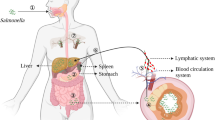Summary
Eimeria brunetti in the chicken undergoes at least three cycles of asexual schizogony before gametogony takes place. First generation schizonts are large, averaging 28.4×21.4 μm in section and containing an average of 318 merozoites. They are to be found in epithelial cells at the base of villi in the mid-intestine. Second generation schizonts can be found 72 hr after infection at the tips of the villi. They are smaller than first generation schizonts, but are very variable in size, containing from 15–120 merozoites similar in size to those of the first generation. Third generation schizonts are developing at 84 hr and are mature by 96 hr. They are in all respects similar to those of the second generation. Developing gametocytes can be found at 108 hr after inoculation and peak oocyst production takes place between 120 and 168 hr. Using single oocyst inoculation, an average reproductive potential of 1.5 million oocysts per oocyst inoculated has been found. Infection causes weight loss or depressed weight gain between 72 and 144 hr, followed by rapid recovery. Pin-point haemorrhagic lesions in all but massive infections are associated with third generation schizogony and gametogony. Marked villus atrophy was observed, but necrotic enteritis was not produced. Early stages predominate in the intestine near the yolk stalk, while subsequent stages spread throughout the length of the intestine.
Similar content being viewed by others
References
Boles, J. I., Becker, E. R.: The development of Eimeria brunetti Levine in the digestive tract of chickens. Iowa State Coll. J. Sci. 29, 1–26 (1954).
Brackett, S., Bliznick, A.: The reproductive potential of five species of coccidia of the chicken as demonstrated by oocyst production. J. Parasit. 38, 133–139 (1952).
Davies, S. F. M.: Eimeria brunetti, an additional cause of intestinal coccidiosis in the domestic fowl in Britain. Vet. Res. 75, 1–4 (1963).
Davies, S. F. M., Joyner, L. P., Kendall, S. B.: Coccidiosis. Edinburgh-London: Oliver & Boyd 1963.
Horton-Smith, C., Long, P. L.: Coccidia and coccidiosis in the domestic fowl and turkey. In: Advances in parasitology, vol. 1, p. 67–107, B. Dawes, ed. London-New York: Academic Press 1963.
Levine, P. P.: A new coccidium pathogenic for chickens, Eimeria brunetti n.sp. (Protozoa: Eimeriidae). Cornell Vet. 32, 430–439 (1952).
Pellérdy, L. P.: Coccidia and coccidiosis. Budapest: Akadémiai Kiadó 1965.
Pout, D. D.: Villus atrophy and coccidiosis. Nature (Lond.) 213, 306–307 (1967).
Author information
Authors and Affiliations
Rights and permissions
About this article
Cite this article
Ryley, J.F., Millard, B.J. & Long, P.L. Further studies on the life cycle of Eimeria brunetti Levine 1942. Z. Parasitenk. 40, 35–48 (1972). https://doi.org/10.1007/BF00329614
Received:
Issue Date:
DOI: https://doi.org/10.1007/BF00329614




